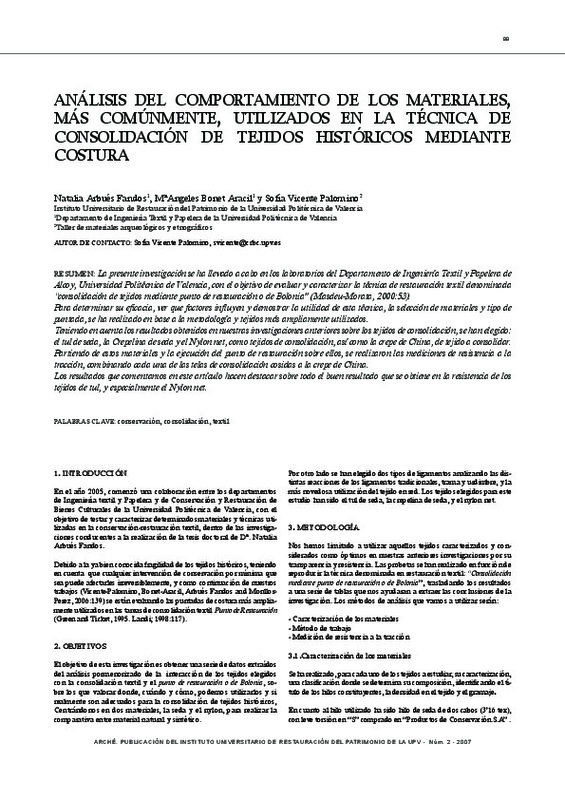JavaScript is disabled for your browser. Some features of this site may not work without it.
Buscar en RiuNet
Listar
Mi cuenta
Estadísticas
Ayuda RiuNet
Admin. UPV
Análisis del comportamiento de los materiales, más comúnmente, utilizados en la técnica de consolidación de tejidos históricos mediante costura
Mostrar el registro sencillo del ítem
Ficheros en el ítem
| dc.contributor.author | Arbues Fandos, Natalia Concepción
|
es_ES |
| dc.contributor.author | Bonet Aracil, María Angeles
|
es_ES |
| dc.contributor.author | Vicente Palomino, Sofía
|
es_ES |
| dc.date.accessioned | 2013-09-20T09:23:28Z | |
| dc.date.available | 2013-09-20T09:23:28Z | |
| dc.date.issued | 2007 | |
| dc.identifier.issn | 1887-3960 | |
| dc.identifier.uri | http://hdl.handle.net/10251/32237 | |
| dc.description.abstract | La presente investigación se ha llevado a cabo en los laboratorios del Departamento de Ingeniería Textil y Papelera de Alcoy, Universidad Politécnica de Valencia, con el objetivo de evaluar y caracterizar la técnica de restauración textil denominada consolidación de tejidos mediante punto de restauración o de Bolonia (Masdeu-Morata, 2000:53). Para determinar su eficacia, ver que factores influyen y demostrar la utilidad de esta técnica, la selección de materiales y tipo de puntada, se ha realizado en base a la metodología y tejidos más ampliamente utilizados. Teniendo en cuenta los resultados obtenidos en nuestras investigaciones anteriores sobre los tejidos de consolidación, se han elegido: el tul de seda, la Crepelina de seda y el Nylon net, como tejidos de consolidación, así como la crepe de China, de tejido a consolidar. Partiendo de estos materiales y la ejecución del punto de restauración sobre ellos, se realizaron las mediciones de resistencia a la tracción, combinando cada una de las telas de consolidación cosidas a la crepe de China. Los resultados que comentamos en este artículo hacen destacar sobre todo el buen resultado que se obtiene en la resistencia de los tejidos de tul, y especialmente el Nylon net. | es_ES |
| dc.description.abstract | This research has been conducted in the laboratories in the Department of Textile Engineering and Paper of Alcoy, belonging to the Polytechnic University of University, in order to characterize and evaluate the textile restoration technique called fabric consolidation through restore stitch or Bologna (Masdeu-Morata, 2000:53). To determine its effectiveness, and to see what factors influence and demonstrate the utility of this technique, the selection of material stitches has been done based on the most widely used methodology and fabrics. By taking into account our results from previous research works on fabric consolidation, we have chosen silk tulle, silk crepe and nylon net as consolidation fabrics, and also Chinese crepe as a fabric to be consolidated. From both these materials and the res¿tore stitch work to be done with them, measurements of traction resistance were taken by combining each fabric sewn to Chinese crepe. The results of this article highlight the good result obtained for fabric resistance of tulle fabrics, especially nylon net. | es_ES |
| dc.format.extent | 4 | es_ES |
| dc.language | Español | es_ES |
| dc.publisher | Instituto Universitario de Restauración del Patrimonio de la UPV | es_ES |
| dc.relation.ispartof | Arché | es_ES |
| dc.rights | Reserva de todos los derechos | es_ES |
| dc.subject | Conservación | es_ES |
| dc.subject | Consolidación | es_ES |
| dc.subject | Textil | es_ES |
| dc.subject | Conservation | es_ES |
| dc.subject | Consolidation | es_ES |
| dc.subject | Textile | es_ES |
| dc.subject.classification | CONSERVACION Y RESTAURACION DE BIENES CULTURALES (UPV) | es_ES |
| dc.title | Análisis del comportamiento de los materiales, más comúnmente, utilizados en la técnica de consolidación de tejidos históricos mediante costura | es_ES |
| dc.title.alternative | Analysis of the performance of commonly used materials in the historical fabric consolidation technique by means of sewing | es_ES |
| dc.type | Artículo | es_ES |
| dc.rights.accessRights | Abierto | es_ES |
| dc.contributor.affiliation | Universitat Politècnica de València. Instituto Universitario de Restauración del Patrimonio - Institut Universitari de Restauració del Patrimoni | es_ES |
| dc.description.bibliographicCitation | Arbues Fandos, NC.; Bonet Aracil, MA.; Vicente Palomino, S. (2007). Análisis del comportamiento de los materiales, más comúnmente, utilizados en la técnica de consolidación de tejidos históricos mediante costura. Arché. (2):99-102. http://hdl.handle.net/10251/32237 | es_ES |
| dc.description.upvformatpinicio | 99 | es_ES |
| dc.description.upvformatpfin | 102 | es_ES |
| dc.description.issue | 2 | es_ES |
| dc.identifier.eissn | 2445-1150 |
Este ítem aparece en la(s) siguiente(s) colección(ones)
-
Arché - Nº 02 : 2007 [27]






